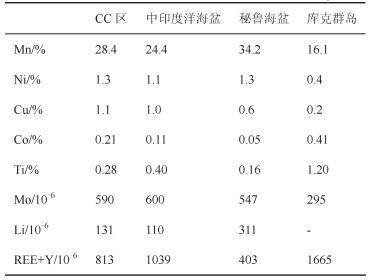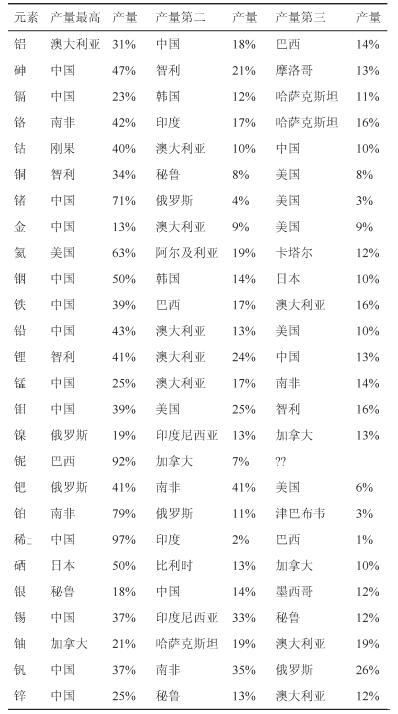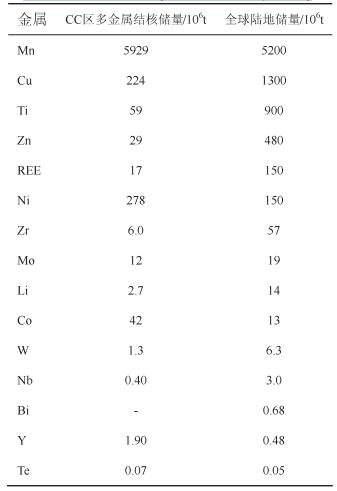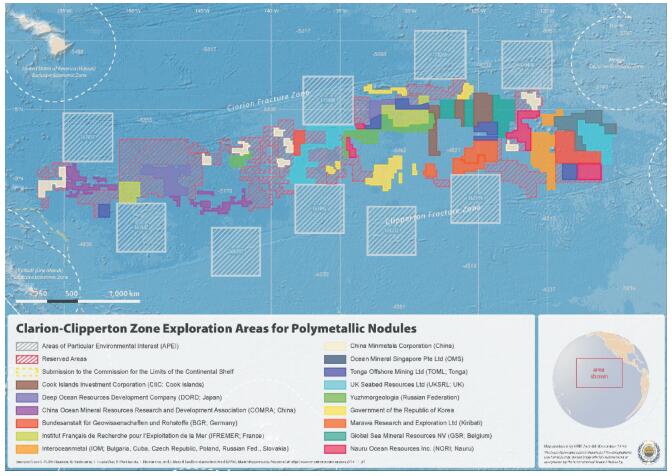The progress in the investigation and study of global deep-sea polumetallic nodules
-
摘要:
随着全球经济的发展,世界各国都面临着严峻的资源危机,而开发利用深海固体矿产资源已成为许多国家的重要选择。人们越来越意识到,海洋已经成为实现新世纪人类社会经济可持续发展的重要空间。随着中国大洋调查的进展,有必要系统梳理世界国际海域深海多金属结核资源调查历程、研究现状及进展。深海多金属结核资源作为可能是海底分布最广、储量最大的金属资源,历来得到国际和国内学者的广泛关注。近几十年的调查和估算表明,全球海洋中大约覆盖了54×106 km2的多金属结核,有商业开采潜力的资源量达75×109 t。但是很多海域涉及到具体区域性的资源调查工作还有待开展,同时在新的理论认识如热液成因和生物化学作用在多金属结核形成过程中的影响以及如何使金属提取过程更加绿色环保和科学高效等学科已经逐渐成为各国学者关注的新方向。中国应该合理有效开展具有针对性的多金属结核调查,争取使中国在深海海域矿产资源的调查和开发工作中走在国际前列。
Abstract:With the global economic development, almost all countries are faced with a serious strategic resource crisis, and the exploitation of deep-sea mineral resources including polymetallic nodules has become a reasonable and effective way to solve this problem. With the progress of China's ocean survey, it is necessary to review the progress, status and future of polymetallic nodules resources. Deep-sea polymetallic nodule resources have attracted much attention among experts all over the world because they are the most widely distributed and most abundant metal resources in the sea floor. The occurrence of bacteria in manganese nodules is recognized and there is a general understanding that their activity may influence the formation of manganese oxide minerals.However, whether microbial activity just modifies Mn nodules or whether their activity is essential for nodule formation is still a matter of debate. The importance of metals contained in polymetallic nodules for the world economy is reflected in their patterns of consumption, their availability as primary or by-product ores in land-based deposits, and their use for merging high-and greentech applications. The research on polymetallic nodules should be carried out effectively so as to make China the leader in this field.
-
Key words:
- deep-sea resources /
- polymetallic nodule /
- research status
-

-
图 1 东太平洋CC区多金属结核调查区分布图(图片来源:isa.org.jm)
Figure 1.
表 1 世界主要海底多金属结核资源区各主要金属元素含量(Petersen S et al., 2016)
Table 1. Mean content of selected elements of manganese nodules in various locations(after S.Petersen et al., 2016)

表 2 全球重要金属元素产量排名表(据Hein et al., 2013b)
Table 2. Leading global metal producers (after Hein et al., 2013b)

表 3 CC区多金属结核与全球陆地相应金属储量对比(据Hein et al., 2013a)
Table 3. Nodules reserve from CCZ compared with Global Lands based reserve (after Hein et al., 2013a)

-
Archer A. 1979. Resources and potential reserves of nickel and copper[C]//Manganese nodules: Dimensions and Perspectives. Reidel Co., Dordrecht, Netherlands, 71-87.
Tebo B M, Clement B G, Dick G J. 2007. Biotransformations of 3[C]//Hurst C J, Crawford R L, Garland J L, Lipson D A, Mills A L, Stetzenbach L D. Manual of Enviromental Microbiology, ASM Press, Washington DC, 1223-1238.
Balaram V, Mathur R, Banakar V K, Hein J R, Rao C R M, Rao T G, Dasaram B. 2006. Determination of the Platinum-Group elements(PGE) and gold (Au) in manganese nodule reference samples by nickel sulfide fire-assay and Tecoprecipitation with ICP-MS[J]. Indian J. Mar. ci., 35:7-16. https://www.researchgate.net/publication/305385882_Determination_of_Platinum-Group_Elements_and_Gold_in_Ferromanganese_Nodule_Reference_Samples
Baturin G N. 1988. The Geochemislry of manganese and manganese Nodules in the ocean[M]. Dordreht, Holland D. Reidel Publishing Compang, 2(2):339-352.
Baturin G N, Yemelyanov, Y M. 1992. Geochemistry of south Atlantic manganese nodlules[J]. Geochem. Int., 29:106-116.
Baturin G N, Dubinchuk V T. 2010. On the composition of ferromanganese nodules of the Indian Ocean[J]. Dokl. Earth Sci., 434 (part 1):1179-1183. https://www.researchgate.net/publication/225470484_On_the_composition_of_ferromanganese_nodules_of_the_Indian_Ocean
Blue Mining. 2014. Breakthrough solutions for the sustainable exploration and extraction of deep sea mineral resources[J]. Programme acronym: FP7-NMP, Subprogramme area: NMP. 2013. 4. 1-2.
Bodey S, Manceau A, Geoffroy N, Baronnet A, Buatier M. 2007.Formation of todorokite from vernadite in Ni——rich hemipelagic sediments[J]. Geochim Cosmochim Acta, 71:5698-5716. doi: 10.1016/j.gca.2007.07.020
Cronan D S. 2006. Processes in the formation of central Pacific manganese nodule deposits[J]. Mar. Sci. Environ, C4, 41-48. https://www.researchgate.net/publication/285869397_Processes_in_the_formation_of_central_Pacific_manganese_nodule_deposits
Cronan D S.1980. Underwater Minerals[M]. Academic Press, Oxford, 363.
Halbach P, Friedrich G, von Stackelberg U. 1988. The manganese nodule belt of the Pacific Ocean[M]. Enke, Stuttgart, 254.
He Gaowen, 2006. A Comparative Study of the Geology, Geochemistry and Metallogenetic Mechanism of Polymetallic Nodules and Cobalt——rich Crust from the Pacific Ocean[D]. Guangzhou. Sun Yat-Sen University, 1-2 (in Chinese with English abstract).
He Gaowen, Sun Xiaoming, Yang Shengxiong, Zhu Kechao, Song Chengbing. 2011. A comparison of REE geochemistry between polymetallic nodules and cobalt-rich crusts in the Pacific Ocean[J].Geology in China, 38(2):462-472 (in Chinese with English abstract). http://www.researchgate.net/publication/286280788_A_comparison_of_REE_geochemistry_between_polymetallic_nodules_and_cobaltrich_crusts_in_the_Pacific_Ocean
Hein J R, Koschinsky A. 2013a. Deep-ocean ferromanganese crusts and nodules[C]//Treatise on Geochemistry, 2nd edition, v. 13, chapter 11, S. Scott (ed), 273-291.
http://www.researchgate.net/publication/259234745_Deep-Ocean_Ferromanganese_Crusts_and_Nodules Hein J R, Mizell K, Koschinsky A, Conrad T A. 2013b. Deep-ocean mineral deposits as a source of critical metals for high-and greentechnology applications:comparison with land-based resources[J]. Ore Geology Reviews, 51:1-14. doi: 10.1016/j.oregeorev.2012.12.001
Hein J R, Conrad TA, Dunham R E. 2009. Seamount characteristics and mine-site model applied to exploration and mining-lease block selection for cobalt-rich ferromanganese crusts[J]. Mar.Georesour. Geotechnol., 27:160-176. doi: 10.1080/10641190902852485
Hein J R, Spinardi F, Okamoto N, Mizell D K, Thorburn A, Tawake. 2015. Critical metals in manganese nodules from the CookIslands EEZ, abundance sand distributions[J]. Ore Geol. Rev., 68:97-116, . doi: 10.1016/j.oregeorev.2014.12.011
International Seabed Authority. 2010. A geological model of polymetallicnodule deposits in the Clarion Clipperton Fracture Zone[J]. International Seabed Authority. Technical Study, 6. http://www.mendeley.com/catalog/geological-model-polymetallic-nodule-deposits-clarion-clipperton-fracture-zone/
Jauhari P, Pattan J N. 2000. Ferromanganese Nodules from the Central Indian Ocean Basin[C]//Cronan D S (Ed. ). Handbook of Marine Mineral Deposits. Boca Raton, CRC Press, 171-195.
http://www.researchgate.net/publication/27668456_Ferromanganese_nodules_from_the_Central_Indian_Ocean_Basin Kato Y, Fujinaga K, Nakamura K, Takaya Y, Kitamura K, Ohta J, Toda R, Nakashima T, Iwamori H. 2011. Deep-sea mud in the Pacific Ocean as a potential resource for rare-earth elements[J]. Nature Geoscience, 4:535-539. doi: 10.1038/ngeo1185
Kildow J T, Bever M B, Dar V K, Capstaff A E. 1976. Assessmentof economicand regulatory conditions affecting ocean minerals resource development[M]. MIT, United States.
Koschinsky A, Alexander B, Bau M, Hein J R. 2010. Rare and valuable metals for high-tech applications found in marine ferromanganese nodules and crusts relationships to genetic endmembers[C]//Proceedings of 39th Underwater Mining Institute/Toward the Sustainable Development of Marine Minerals: Geological, Technological and Economic Aspects, 1-14.
http://www.researchgate.net/publication/264382816_Rare_and_Valuable_Metals_for_High-Tech_Applications_Found_in_Marine_Ferromanganese_Nodules_and_Crusts_Relationships_To_Genetic_Endmembers Koschinsky A, Hein J R. 2003. Acquisition of elements from seawater by ferromanganese crusts:Solid phase associations and seawater speciation[J]. Mar. Geol., 198:331-351. doi: 10.1016/S0025-3227(03)00122-1
Manceau A, Lanson M, Takahashi Y. 2014. Mineralogy and crystal chemistry of Mn, Fe, Co, Ni, and Cu in a deep-sea Pacific polymetallic nodule[J]. Am. Mineral., 99:2068-2083. doi: 10.2138/am-2014-4742
Mero J L. 1965. The Mineral Resources of the Sea[M]. Elsevier Publishing Company.
Morgan C L. 2000. Resource estimates of the Clarion-Clipperton manganese nodule deposits[C]//Cronan DS (ed. ) Handbook of Marine Mineral Deposits, Boca Raton, FL: CRC Press, 145-170.
http://www.researchgate.net/publication/284324559_Resource_estimates_of_the_Clarion-Clipperton_manganese_nodule_deposits Mukhopadhyay R, Ghosh AK. 2010. Dynamics of formation of ferromanganese nodules in the Indian Ocean[J]. J. Asian Earth Sci., 37:394-398. doi: 10.1016/j.jseaes.2009.09.003
Mukhopadhyay R, Ghosh AK, Iyer SD. 2008. The Indian Ocean Nodule Field: Geology and Resource Potential[C]//Hale M (series editor) Handbook of exploration and environmental geochemistry no. 10. Elsevier, Amsterdam, 292.
https://www.researchgate.net/publication/27667848_The_Indian_Ocean_nodule_field_Geology_and_resource_potential Peacock C L, Sherman D M. 2007a. Crystal-chemistry of Ni in marine ferromanganese crusts and nodules[J]. Am. Mineral, 92:1087-1092. doi: 10.2138/am.2007.2378
Peacock C L, Sherman D M. 2007b. Sorption of Ni by birnessite:equilibrium controls on Ni in seawater[J]. ChemGeol, 238:94-106. https://www.sciencedirect.com/science/article/pii/S0009254106005006
Rona P A. 2008. The Changing Vision of Marine Minerals[J]. Ore Geology Reviews, 33:618-666. doi: 10.1016/j.oregeorev.2007.03.006
Schulz H. 2000. Quantification of early diagenesis:dissolved constituents in pore water and signals in the solid marine geochemistry[J]. Springer, 73-124. https://www.researchgate.net/publication/226566000_Quantification_of_Early_Diagenesis_Dissolved_Constituents_in_Pore_Water_and_Signals_in_the_Solid_Phase
Sedysheva T Y, Melnikov M Y. 2012. Role of ore-bearing factor in evaluating of ore areas of Co-rich ferromanganese crusts[C]//Mineral of the Ocean-6 & Deep-Sea Minerals and Mining-3/Joint International Conference Abstracts. SPb. : VNIIOkeangeologia, 79-81.
Siddiquie H N, Dasgupta D R, Sengupta N R, Srivastava P C, Malik T K. 1978. Manganese iron nodules from the Indian Ocean, Indian[J]. Mar. Sci., 7:239-253.
Takahashi Y, Manceau A, Geoffroy N, Marcus M A, Usui A. 2007.Chemical and structural control of the partitioning of Co, Ce, and Pb in marine ferromanganese oxides[J]. Geochim Cosmochim Acta, 71:984-1008. doi: 10.1016/j.gca.2006.11.016
Tao Chunhui, Wu Tao, Jin Xiaobing, Dou Bingjun, Li Huaiming, Zhou Jianping. 2013. Petrophysicalcharacteristics of rocks and sulfides from the SWIR hydrothermal field[J]. ActaOceanologicaSinica, 32(12):118-125. https://link.springer.com/article/10.1007/s13131-013-0367-4
Tebo B M, Clement B G, and Dick G J. 2007. Biotransformations of manganese[C]//Hurst C J, Crawford R L, Garland J L, Lipson D A, Mills A L, and Stetzenbach L D (eds. ). Manual of Environmental Microbiology, 3rd edn. Washington, D C: ASM Press, 1223-1238.
UsuiA, Someya M. 1997. Distribution and composition of marine hydrogeneticand hydrothermal manganese deposits in the northwest Pacific[C]//NicholsonK, HeinJ R, BühnB, DasguptaS. (Eds. ). Manganese Mineralization: Geochemistry and Mineralogy of Terrestrial and Marine Deposits. Geological Society of London Special Publication No. 119, 177-198.
http://adsabs.harvard.edu/abs/1997GSLSP.119..177U Verlaan P A, Cronan D S, Morgan C L. 2004. A comparative analysis of compositional variations in and between marine ferromanganese nodules and crusts in the South Pacific and their environmental controls[J]. Prog. Ocean Ogr., 63:125-158. doi: 10.1016/j.pocean.2004.11.001
Villalobos M, Bargar J, Sposito G. 2005. Trace metal retention on biogenic manganese oxide nanoparticles[J]. Elements, 1:223-226. doi: 10.2113/gselements.1.4.223
Villalobos M, Toner B, Bargar J, Sposito G. 2003. Characterization of the manganese oxide produced by Pseidomonasputida strain MnB1[J]. Geochimica et CosmochimicaActa 67:2649-2662. doi: 10.1016/S0016-7037(03)00217-5
Vineesh T C, Nagender Nath B, Banerjee R, Jaisankar S, Lekshmi V. 2009. Manganese nodule morphology as indicators for oceanic processes in the Central Indian Basin[J]. International Geology Review, 51(1):27-44. doi: 10.1080/00206810802622773
Von Stackelberg U. 2000. Manganese nodules of the Peru Basin[C]//Cronan DS (ed. ). Handbook of Marine Mineral Deposits. Boca Raton, FL: CRC Press, 197-238.
http://www.researchgate.net/publication/313055341_Manganese_nodules_of_the_Peru_basin Wang Fenlian, He Gaowen, Sun Xiaoming, Yang Yang, Zhao Taiping. 2016. The host of REE + Y Elements in deep-sea sediments from the Pacific Ocean[J]. Acta Petrologica Sinica, 32(7):2057-2068(in Chinese with English abstract). http://www.en.cnki.com.cn/Article_en/CJFDTotal-YSXB201607009.htm
Wang Haifeng, Liu Yonggang, Zhu Kechao. 2015. Polymetallicnodules distribution in the Central Pacific Basin and comparison with nodules in China Pioneer Area CC Zone[J]. Marine Geology & Quaternary Geology, 35(2):73-79 (in Chinese with English abstract). http://www.en.cnki.com.cn/Article_en/CJFDTOTAL-HYDZ201502011.htm
Wegorzewski A, Kuhn T, Dohrmann R, Wirth R, Grangeon S.2015.Mineralogical characterization of individual growth structures of Mn——nodules with different Ni + Cu content from the central Pacific Ocean[J]. Am Mineral 100:2497-2508. doi: 10.2138/am-2015-5122
Xu Dongyu. 1994. The Paleo Marine Environment of Polymetallic Nodule Formation[M]. Beijing. Geological Publishing House(in Chinese with English abstract).
Zhang Zhenguo. 2007. Approach to Geochemical Characteristics and Minerogenetic Environment of Polymetallic Nodules from the North Continental Margin of the South China Sea[D]. Beijing. China University of Geosciences (Beijing), 4-5 (in Chinese with English abstract).
Zhu Kechao, Li Zhenshao, He Gaowen, Zhao Zubin, Zeng Ruijian, Chen Shengyuan, Zhu Benduo. 2001. Polymeticallic Nodules Resource from the East Pacific Ocean[M].Beijing:Geological Publishing House(in Chinese with English abstract).
何高文, 孙晓明, 杨胜雄, 朱克超, 宋成兵. 2011.太平洋多金属结核和富钴结壳稀土元素地球化学对比及其地质意义[J].中国地质, 38(2):462-472. http://geochina.cgs.gov.cn/ch/reader/view_abstract.aspx?file_no=20110220&flag=1
何高文. 2006. 太平洋多金属结核和富钴结壳抵制地球化学特征与成矿机制对比研究[D]. 广州: 中山大学, 1-2.
http://www.wanfangdata.com.cn/details/detail.do?_type=degree&id=Y924721 王汾连, 何高文, 孙晓明, 杨阳, 赵太平. 2016.太平洋富稀土深海沉积物中稀土元素赋存载体研究[J].岩石学报, 32(7):2057-2068. http://d.old.wanfangdata.com.cn/Periodical/ysxb98201607009
王海峰, 刘永刚, 朱克超. 2015.中太平洋海盆多金属结核分布及其与CC区中国多金属结核开辟区多金属结核特征对比[J].海洋地质与第四纪地质, 35(2):73-79. http://kns.cnki.net/KCMS/detail/detail.aspx?filename=hydz201502011&dbname=CJFD&dbcode=CJFQ
许东禹. 1994.多金属结核形成的古海洋环境[M].北京:地质出版社.
张振国. 2007. 南海北部陆缘多金属结核地球化学特征及成矿意义[D]. 北京: 中国地质大学(北京), 4-5.
http://www.wanfangdata.com.cn/details/detail.do?_type=degree&id=Y1784533 朱克超, 李振韶, 何高文, 赵祖斌, 曾瑞坚, 陈圣源, 朱本铎. 2001.东太平洋多金属结核矿产[M].北京:地质出版社.
-




 下载:
下载:

